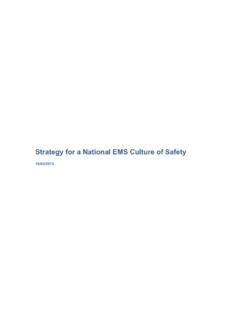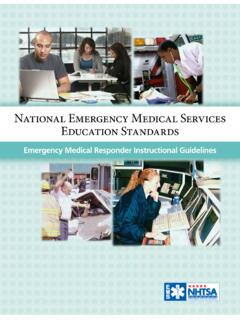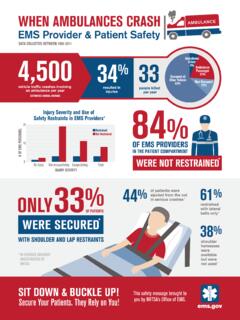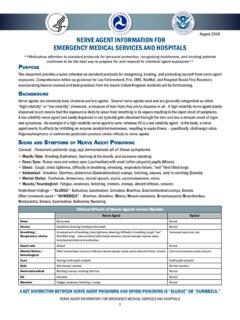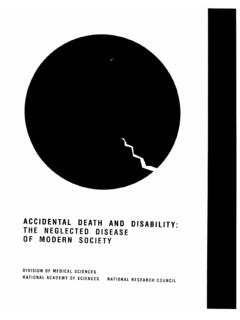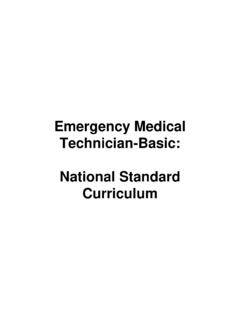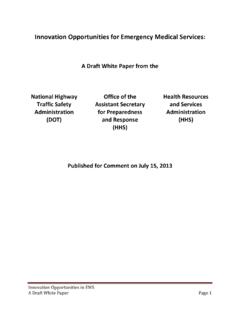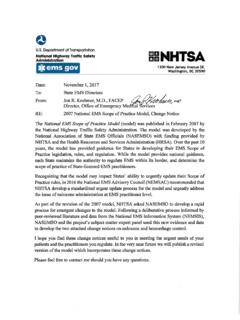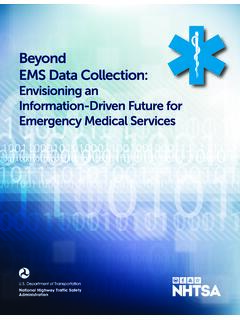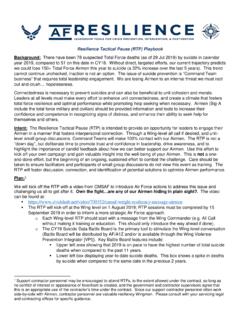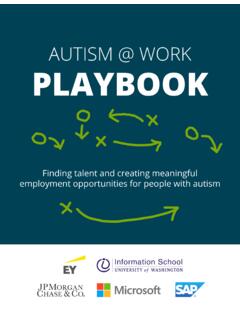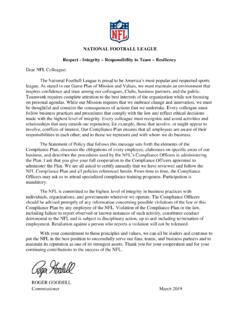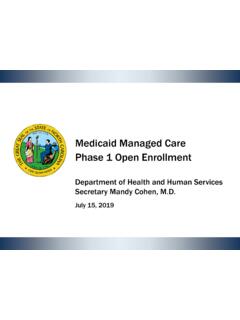Transcription of EMS Infectious Disease Playbook
1 EMS Infectious . Disease Playbook . This document was created using official or best practice information taken from multiple organizations that was vetted and assembled by subject matter experts working for the Technical Resources, Assistance Center, and Information Exchange (TRACIE) at the request of the Department of Health and Human Services (HHS)/Office of the Assistant Secretary for Preparedness and Response (ASPR). The aim was not to develop novel guidance for emergency medical services (EMS) agencies, but to unify multiple sources of information in a single planning document addressing the full spectrum of Infectious agents to create a concise reference resource for EMS agencies developing their service policies. This document does not represent official policy of HHS/ASPR or other federal or private agencies.
2 The information contained in this Playbook is intended as a planning resource, and should be incorporated into agency standard operating procedures and reviewed by the EMS medical director. There is not one correct way to don and doff personal protective equipment;. EMS agencies should review the guidelines and their specific circumstances to develop procedures that are ensemble and site appropriate. Appropriate education and training is critical to the success of infection prevention and control protocols. The authors, TRACIE, and HHS/ASPR take no responsibility and bear no liability for any clinical care outcomes, provider injury/illness, or inaccuracies in or resulting from this document. All recommendations were current at the time of publication and vetted to the best of our ability.
3 Inclusion of specific references and resources is offered as an acknowledgement of their contribution of material and for additional information for EMS planners, but does not constitute endorsement or vouch for accuracy or applicability of the referenced documents. Back to Contents EMS Infectious Disease Playbook . Contents 1 D I S PATCH/RE SPO NDE R ACTIO NS. 11 S TA N DARD PRE CAUTIO NS. 15 C O N TACT PRECAUTIO NS. 21 D R O P L ET PRE CAUTIO NS. 27 A I R B ORNE PRE CAUTIO NS. 33 S P E C IAL RESPIRATO RY PRECAUTIO NS. 42 E V D - V HF PRE CAUTIO NS. 65 R E S O URCES/SPECIAL CO NSIDE RATIO NS. EMS Infectious Disease Playbook . Dispatch/ Special Resources/. Responder Standard Contact Droplet Airborne EVD-VHF. Respiratory Special Actions Precautions Precautions Precautions Precautions Precautions Precautions Considerations Dispatch/Responder Actions G E NER A L PR IN CIPLES CA LL TA K ING / D IS PATCH.
4 Safe response by EMS requires an integrated approach: Appropriate information from the caller and dispatcher; appropriate protocols for response, clinical care, application of administrative and environmental controls and use of personal protective equipment (PPE) by responding EMS personnel; and transport to a hospital that can provide effective evaluation and treatment of the suspected condition. Ideally, 911 call takers/emergency medical dispatchers will identify possible Infectious Disease patients through integrated routine screening questions and relay that information to emergency responders prior to their arrival on the scene. During the caller interrogation, if information about communicable diseases is offered, make sure the information is documented and relayed to responders in accordance with established policies on how to share patient-related information.
5 Screening for suspected highly Infectious pathogens often involves questioning patients about recent travel to endemic areas and presenting signs and symptoms. The timeframe for these conditions varies ( , 14 days for Middle East Respiratory Syndrome (MERS), 21 for Ebola Virus Disease (EVD)); 21 days is used in the general screen for consistency since this is inclusive of the diseases, but can be adjusted as required if screening for specific pathogens. Local screening questions may be needed during outbreaks and can be inserted into the dispatch algorithm and keyed to the appropriate precautions. EMS agencies should consult with local and state public health and EMS authorities to identify required modifications to processes and protocols to ensure consistency with CDC guidance.
6 If persons under investigation for a highly Infectious Disease are known to public health, it may be beneficial for public safety to enter a temporary note on their address in the computer-aided dispatch system to alert 911 responders to the potential for illness/. exposure. This is a local decision dependent on the systems and policies in the community and the note should be removed once the Infectious period has passed. Fever may be a helpful contributing sign or symptom, but should not be used exclusively to determine the presence or absence of Disease as it is not universally present in cases of serious communicable diseases. Back to Contents EMS Infectious Disease Playbook 1-1. Dispatch/ Special Resources/. Responder Standard Contact Droplet Airborne EVD-VHF. Respiratory Special Actions Precautions Precautions Precautions Precautions Precautions Precautions Considerations Dispatch/Responder Actions G E NER A L PR IN CIPLES R ES PO N S E.
7 Regardless of dispatch information, EMS personnel should be vigilant for travel history and signs and symptoms of communicable Disease ( , fever, cough, gastrointestinal complaints) and use standard precautions and add appropriate transmission-based infection control precautions whenever history or exam findings warrant. Implement strict standard and transmission-based precautions based on the patient's clinical information to avoid exposure to potentially Infectious bodily fluids, droplets, and airborne particles. Avoid direct contact with a patient who may have a serious communicable Disease until you are wearing appropriate Maintaining a distance of at least six feet may provide protection from transmission of many diseases. Understand and practice with PPE so that you can rapidly and safely don and carefully doff the equipment without cross-contamination.
8 Patients or their caregivers may find responders wearing high levels of PPE such as hood, suits, and respirators alarming. Communicating with and calming anxious patients may be more challenging due to PPE as well. Responders should be mindful of this and be prepared to reassure patients and to address their distress and fear. Limit the number of EMS providers making contact with a potentially Infectious patient to the minimum required to perform tasks safely. EMS must be able to implement effective infection control practices to afford emergency responder safety while avoiding excessive delays in care. Training and practice should allow EMS personnel to provide emergent medical care without waiting for specialized response. 1. The maximum distance for droplet transmission is unresolved.
9 While the area of defined risk has historically been a distance of less than 3 feet from the patient, experimental smallpox studies and SARS investigations suggest droplets could be transmitted 6 feet or more. The recommendation to maintain a distance of 6 feet or more is used throughout this document to be conservative given the uncertainty. Page 17 of gov/hicpac/pdf/ provides additional details. Back to Contents EMS Infectious Disease Playbook 1-2. Dispatch/ Special Resources/. Responder Standard Contact Droplet Airborne EVD-VHF. Respiratory Special Actions Precautions Precautions Precautions Precautions Precautions Precautions Considerations Dispatch/Responder Actions GE NE R A L P R I N C I P L ES RESPO NSE, CO NTINUE D. Specialized transport should be reserved for stable suspect serious communicable Disease patients ( , EVD, Marburg Disease , smallpox) or for inter-facility transport of those with suspected or known Disease .
10 Many communities will also have dedicated Infectious Disease medical transport services built into their regional transportation plan for planned patient movements. Hand hygiene ( , handwashing with non-antimicrobial soap and water, alcohol-based hand rub, or antiseptic handwash) is one of the best ways to remove germs, avoid getting sick, and prevent the spread of germs to others. Placing a surgical mask on a patient with likely Infectious cough significantly limits droplet generation. Patients should cover their nose and mouth when coughing or sneezing; use tissues to contain respiratory secretions and, after use, dispose them in the nearest waste receptacle; and perform hand hygiene after having contact with respiratory secretions and contaminated objects or materials.
